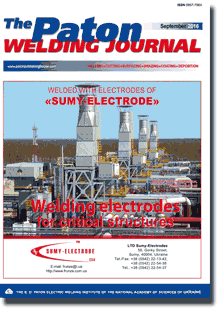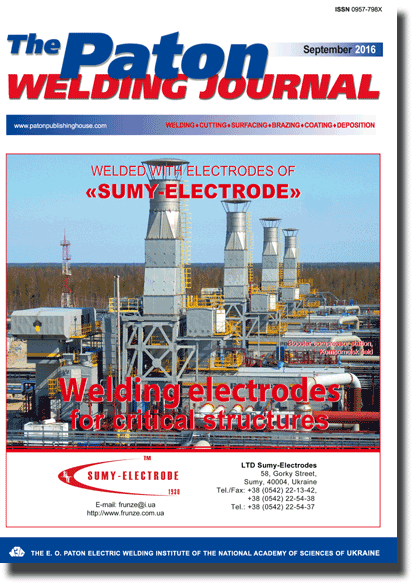| 2016 №09 (11) |
DOI of Article 10.15407/tpwj2016.09.12 |
2016 №09 (01) |

The Paton Welding Journal, 2016, #9, 55-58 pages
Modern approaches to performance of toxicological and hygienic studies of welding fumes (Review)
A.O. Lukianenko1 and A.V. Demetskaya2
1E.O. Paton Electric Welding Institute, NASU 11 Kazimir Malevich Str., 03680, Kiev, Ukraine. E-mail: office@paton.kiev.ua
2Institute of Occupational Medicine, NAMSU 75 Saksagansky Str., 01033, Kiev, Ukraine
Abstract
The paper provides an overview of the results of studying the nanoscale fractions in the working zone air during welding operations and in the welder’s breathing zone, as well as data of toxicological studies of welding fumes (WF) in experiments on laboratory animals (in vivo) and in cell culture experiments (in vitro). It is suggested that the high disease rate in welders can be caused not only by toxicity of WF components having irritating and mutagenic effects, but also by the ability of nanoscale particles (nanoparticles) to penetrate deeply into the tissues. The data of hygienic studies of nanoparticle emission into the working zone air during welding operations, as well as of studying nanoscale fraction deposition in the respiratory tract of welders are presented. It is shown that decrease in the content of hexavalent chromium and manganese in the welding consumable involves increasing the concentrations of other metals, and thus does not guarantee safety for the welder. The role of prediction of WF harmful effects on the body by controlling the working conditions using modern hygienic approaches is substantiated. Simultaneous application of in vitro and in vivo methods to provide the most complete information about the potential hazards of WF, peculiarities of biological action of its components, as well as the need to develop not only informative, but also less time-consuming and costly express-methods of screening assessment of toxicity of WF, generated at different types of welding was substantiated. These methods will allow evaluation of the cumulative effect of the impact of totality of toxicants present in WF solid component, including unidentified components. 21 Ref.
Keywords: welding fumes, solid component of welding fume, working zone air, cytotoxicity, in vitro, in vivo, nanoparticles
Received: 10.03.16
Published: 09.10.16
References
- Levchenko, O.G. (2010) Occupational safety in welding productionn: Tutorial. Kyiv: Osnova.
- Leonard, S.S., Chen, B.T., Stone, S.G. et al. (2010) Comparison of stainless and mild steel welding fumes in generation of reactive oxygen species. Part Fibre Toxicol., Nov. 3. https://doi.org/10.1186/1743-8977-7-32
- Gorban, L.M., Timoshina, D.P. (2004) Factors of professional risk of workers of modern welding production and ways for optimizing of their labor conditions. In: of 24th Congress of Hygienists of Ukraine on Hygienic Sci. and Practice at the Boundary of Centuries, Vol. 2, 69–71.
- Kusraeva, Z.S. (2011) Assessment of professional risk in modern methods of electric arc welding and cutting of metals: Syn. of Thesis for Cand. of Medical Sci. Degree. St.-Petersburg.
- Zheng, W., Antonini, J.M., Lin, Y.C. et al. (2015) Cardiovascular effects in rats after intratracheal instillation of metal welding particles. Inhal Toxicol., 27(1), 45–53. https://doi.org/10.3109/08958378.2014.982309
- Oberdoerster, G. (2010) Safety assessment for nanotechnology and nanomedicine: Concepts of nanotoxicology. Int. Med., 267(1), 89–105. https://doi.org/10.1111/j.1365-2796.2009.02187.x
- Elder, A., Gelein, R., Silva, V. et al. (2006) Translocation of inhaled ultrafine manganese oxide particles to the central nervous system. Health Perspect., 114(8), 1172–1178. https://doi.org/10.1289/ehp.9030
- Stepanyuk, S.M., Pokhodnya, I.K., Yavdoshchin, I.R. (2012) Study of morphology, chemical composition and dispersion of particles of Ts3A welding electrodes with different types of coatings. In: of 2nd All-Ukrainian Sci.-Techn. Conf. of Junior Sci. and Students (Ukraine, Koblevo, 4–8 Sept. 2012).
- Cena, L.G., Chisholm, W.P., Keane, M.J. et al. (2015) A field study on the respiratory deposition of the nano-sized fraction of mild and stainless steel welding fume metals. Occup. Environ. Hyg., 12(10), 721–728. https://doi.org/10.1080/15459624.2015.1043055
- Demetska, O.V., Leonenko, O.B., Tkachenko, T.Yu. et al. (2012) Dynamics of concentration of ultradispersed particles in manual welding with electrodes. Zhurnal z Medycyny Pratsi, 1, 3–7.
- James, M., Antonini, J.M. (2003) Health effects of welding. Critical Rev. in Toxicology, 33(1), 61–103. https://doi.org/10.1080/713611032
- Antonini, J.M., Roberts, J.R., Stone, S. et al. (2011) Persistence of deposited metals in the lungs after stainless steel and mild steel welding fume inhalation in rats. Toxicol., 85(5), 487–498. https://doi.org/10.1007/s00204-010-0601-1
- Antonini, J.M., Badding, M.A., Meighan, T.G. et al. (2014) Evaluation of the pulmonary toxicity of a fume generated from a nickel-, copper-based electrode to be used as a substitute in stainless steel welding. Health Insights, 15(8), 11–20. https://doi.org/10.4137/EHI.S15260
- Pokhodnya, I.K., Suprun, S.A., Onoprienko, E.N. (1983) Occupational hygiene. Mezhved. Sbornik Zdorovie, Issue 19, 37–43.
- Antonini, J.M., Lawryk, N.J., Krishna Murthy, G.G. et al. (1999) Effect of welding fume solubility on lung macrophage viability and function in vitro. Toxicol. Environ. Health, 58, 343–363. https://doi.org/10.1080/009841099157205
- Maxild, J., Andersen, M., Kiel, P. et al. (1978) Mutagenicity of fume particles from metal arc welding on stainless steel in the salmonella/microsome test. Res., 56, 235–243. https://doi.org/10.1016/0027-5107(78)90190-2
- Baker, R.S.U., Arlauskas, A., Tandon, R.K. et al. (1986) Toxic and genotoxic action of electric arc welding fumes on cultured mammalian cells. Appl. Toxicol., 6, 357–362. https://doi.org/10.1002/jat.2550060510
- Biggart, N.W., Rinehart, R.R., Verfaille, J. (1987) Evidence for the presence of mutagenic compounds other than chromium in particles from mild steel welding. Res., 180, 55–65. https://doi.org/10.1016/0027-5107(87)90066-2
- Elias, Z., Poirot, O., Baruthio, F. et al. (1991) Role of solubilized chromium in the induction of morphological transformation of Syrian hamster embryo (SHE) cells by particulate chromium (VI) compounds. Carcinogenesis, 12, 1811–1816. https://doi.org/10.1093/carcin/12.10.1811
- Hansen, K., Stern, R.M., Fletcher, A. et al. (1985) Nickel and chromium compounds and welding fumes in mammalian cell transformation bioassay in vitro. In: Biological effects and health hazards of welding fumes and gases, 305–310. Amsterdam: Elsevier Press.
- Badding, M.A., Fix, N.R., Antonini, J.M. et al. (2014) A comparison of cytotoxicity and oxidative stress from welding fumes generated with a new nickel-, copper-based consumable versus mild and stainless steel-based welding in RAW 264.7 mouse macrophages. PLOS ONE, 9(6), 11–20. https://doi.org/10.1371/journal.pone.0101310
Suggested Citation
A.O. Lukianenko and A.V. Demetskaya (2016) Modern approaches to performance of toxicological and hygienic studies of welding fumes (Review). The Paton Welding J., 09, 55-58.The cost of subscription/purchase order journals or individual articles
| Journal/Currency | Annual Set | 1 issue printed |
1 issue |
one article |
| TPWJ/USD | 384 $ | 32 $ | 26 $ | 13 $ |
| TPWJ/EUR | 348 € | 29 € | 24 € | 12 € |
| TPWJ/UAH | 7200 UAH | 600 UAH | 600 UAH | 280 UAH |
| AS/UAH | 1800 UAH | 300 UAH | 300 UAH | 150 UAH |
| AS/USD | 192 $ | 32 $ | 26 $ | 13 $ |
| AS/EUR | 180 € | 30 € | 25 € | 12 € |
| SEM/UAH | 1200 UAH | 300 UAH | 300 UAH | 150 UAH |
| SEM/USD | 128 $ | 32 $ | 26 $ | 13 $ |
| SEM/EUR | 120 € | 30 € | 25 € | 12 € |
| TDNK/UAH | 1200 UAH | 300 UAH | 300 UAH | 150 UAH |
| TDNK/USD | 128 $ | 32 $ | 26 $ | 13 $ |
| TDNK/EUR | 120 € | 30 € | 25 € | 15 € |
AS = «Automatic Welding» - 6 issues per year;
TPWJ = «PATON WELDING JOURNAL» - 12 issues per year;
SEM = «Electrometallurgy Today» - 4 issues per year;
TDNK = «Technical Diagnostics and Non-Destructive Testing» - 4 issues per year.


